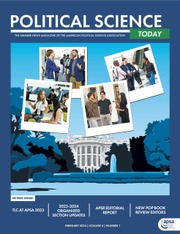EDITOR'S NOTE
We produced this essay by adapting a portion of Gary King's longer working paper, “Education and Scholarship by Video,” available in full at GaryKing.org/videos. Part of his original essay includes discussions of best practices in producing and editing educational and research videos; you can see that section in the APSA Educate blog post at bit.ly/3zAPRj9.
—Bennett Grubbs, American Political Science Association
INTRODUCTION
A couple years ago I designed a new format for videos, recorded all my lectures for Quantitative Social Science Methods I—the first course in the Harvard Government Department’s graduate methods sequence—and made them freely available. (My videos are on YouTube, see GaryKing.org/vpresent; details on my class are at j.mp/G2001). This paper is in response to questions I’ve received or wrestled with about technology, open educational resources, and pedagogy. The following briefly reflects on why I turned to the hybrid and open access approach, before quickly discussing how I use the videos as a pedagogical tool to engage students and prepare for in-class sessions. In a separate resource, I report on efforts toward do-it-yourself video production designed as optimally as I could find for our educational goals. This resource’s operating theory is to put in all the technical effort up front as startup costs, so that you can then focus on content.

WHY RECORD LECTURES?
Live lecturing is great for the lecturer. It is fun and rewarding. I love it. Interruptions and questions enable you to adjust your talk to the audience. After all, teaching teaches the teacher, and so when you lecture you learn a lot. Unfortunately, live lectures are not as great for the audience. Students can ask questions, but doing so holds up everyone else, and so most are unasked and unanswered. We know from research in psychology that, on average, people in day-to-day life are not paying attention to what’s going on about 50% of the time (see the discussion in King and Sen Reference King and Sen2013). I am not sure we even want to know what the percentage is among those at the back of a big lecture hall! Odds are, the most important unasked question is “I just spaced out and missed that; say again?” Of course, few will embarrass themselves and ask that but, are happy to hit rewind, pause, or fast forward.
A good class is an engaging collective experience and provides a feeling sociologists refer to as “collective effervescence.” If you get together with students physically (or virtually) in a class, why not talk with them, and engage with them, rather than lecturing at them while they sit there passively? From the same psychological research discussed above, we know that if you’re engaged in conversation, we’re mind wandering only about half as often (25% of the time), so a conversation in class seems wise. When assigning a book, you read it word for word to your class. I think of my recorded lectures as the equivalent of a book.
WHY GIVE THE VIDEOS AWAY?
It’s good for academics in the rest of the world (and judging from all the communications I’ve received, they definitely appreciate it) but, in our field, the more we give away, the more we get. For example, if you share your writings, I’ll learn something, you may benefit from feedback, others can build on your work, and we all benefit from the interaction. We learned the same lesson when sharing data (King Reference King1995; Reference King2006), teaching materials (Clements, Pawlowski, and Manouselis Reference Clements, Pawlowski and Manouselis2015), and other scholarly products (Esarey and Wood Reference Esarey and Wood2018). In addition, most of the material in my lectures I learned for, with, or from generations of students who might find the videos useful when they teach.
HOW SHOULD WE USE VIDEOS FOR CLASS?
I do not point students to the YouTube videos. Instead, I have students watch the videos in Perusall.com, a free platform my collaborators and I developed. Perusall turns reading text and watching videos from solitary experiences into engaging collective ones. Students annotate the video timeline (and passages in textbooks, articles, problem sets, pictures, code, etc.) and then respond to each other’s questions and comments in threads, Facebook-style. They also interact with Slack-like chat channels and in other ways. With some novel algorithms, Perusall automatically manages the out-of-classroom student experience (without instructor involvement), and ensures students do the work, get full credit, and are motivated. You can use Perusall in your class by going to the site and setting up a course. If you’d like to use it with my videos, go to Perusall.com, create your own course, and then use “copy code” 6AFEYRZH4P, and all the videos will be pulled into your course automatically. Either way, you can then sign up your students (directly or through your learning management system like Canvas or Blackboard).
Before I walk (or Zoom) into class, I print out Perusall’s “student confusion report,” which summarizes the student annotations and interactions and gives me the key points to lead a discussion. This works far better than “any questions?” (which seem to be hypnotic power words for generating blank stares). I then use class time to optimize learning, which involves in my case (1) returning to the big picture—where we have come and where we are going—(2) zooming in to a few key points of confusion apparent from Perusall (using slides, sometimes from the recorded lectures, or occasionally prepared and presented by the students involved), and (3) connecting important points to memorable stories, research, or demonstrations.
Class then complements out-of-class preparation: A good book, or the equivalent in a set of recorded lectures, is highly organized, following a table of contents, in a predictable order, with minimal repetition. In contrast, research in education shows that learning also requires the opposite which, in the language of the field, includes interleaving (sampling from topics randomly rather than sequentially), spacing (studying a little each day rather than all at once), feedback (making yourself vulnerable to being proven wrong), and metacognition (understanding what you know and don’t know, and how to learn) (see Agarwal and Bain Reference Agarwal and Bain2019; Brown, Roediger, and McDaniel Reference Brown, Roediger and McDaniel2014). Recorded lectures, then, free up class from the textbook-like presentations, enabling activities to enhance learning (Crouch and Mazur Reference Crouch and Mazur2001). ■
CALL FOR MATERIALS: NEW APPROACHES TO POLITICAL SCIENCE EDUCATION
APSA Educate invites submissions of teaching and learning resources showcasing new approaches to political science education. Political scientists have responded to the past decade’s political, economic, social, technological, and biological upheavals by rethinking many disciplinary assumptions. At the same time, these events have altered how political scientists share knowledge with students. Taking stock of these changes, we ask:
-
• How are political science educators rethinking introductory political science courses?
-
• How are political science faculty empowering a new generation of students to be knowledgeable civic leaders?
-
• In what ways are educators responding to opportunities for global interconnectedness and learning from a diverse range of perspectives and issues?
-
• What new tools are instructors deploying to connect with students?
APSA Educate welcomes submissions of teaching & learning resources from political science educators at all levels—fulltime faculty, contingent faculty, graduate students, and high school instructors. We also encourage submissions from educators at institutions outside the United States.
Examples of teaching resources might include: syllabi, active learning assignments, OER textbooks, recorded lectures, podcasts, virtual and in person simulations, civic engagement tools, and other teaching materials developed over the past few years. Educate also accepts 1000-word blog posts discussing best practices in political science education and civic engagement. Please upload your materials via APSA Educate’s single page submission form. Please send all blog submissions to educate@apsanet.org.




